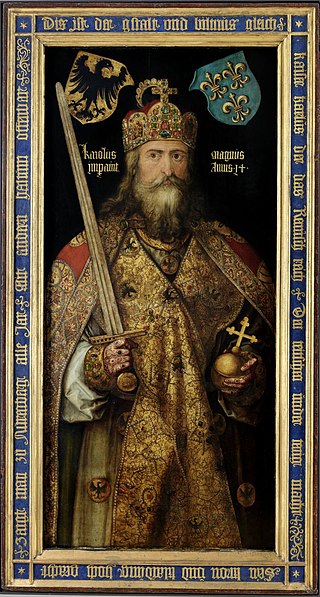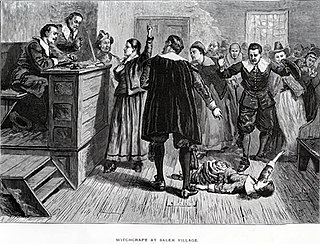
Genealogy is the study of families, family history, and the tracing of their lineages. Genealogists use oral interviews, historical records, genetic analysis, and other records to obtain information about a family and to demonstrate kinship and pedigrees of its members. The results are often displayed in charts or written as narratives. The field of family history is broader than genealogy, and covers not just lineage but also family and community history and biography.

The Salem witch trials were a series of hearings and prosecutions of people accused of witchcraft in colonial Massachusetts between February 1692 and May 1693. More than 200 people were accused. Thirty people were found guilty, nineteen of whom were executed by hanging. One other man, Giles Corey, died under torture after refusing to enter a plea, and at least five people died in jail.
John Proctor was a landowner in the Massachusetts Bay Colony. He and his wife Elizabeth were tried and convicted of witchcraft as part of the Salem Witch Trials, whereupon he was hanged.
Genetic genealogy is the use of genealogical DNA tests, i.e., DNA profiling and DNA testing, in combination with traditional genealogical methods, to infer genetic relationships between individuals. This application of genetics came to be used by family historians in the 21st century, as DNA tests became affordable. The tests have been promoted by amateur groups, such as surname study groups or regional genealogical groups, as well as research projects such as the Genographic Project.
Thomas Danforth was a politician, magistrate, and landowner in the Massachusetts Bay Colony. A conservative Puritan, he served for many years as one of the colony's councilors and magistrates, generally leading opposition to attempts by the English kings to assert control over the colony. He accumulated land in the central part of the colony that eventually became a portion of Framingham, Massachusetts. His government roles included administration of territory in present-day Maine that was purchased by the colony.
A family history society or genealogical society is a society, often charitable or not-for-profit, that allows member genealogists and family historians to profit from shared knowledge. Large societies often own libraries, sponsor research seminars and foreign trips, and publish journals. Some societies concentrate on a specific niche, such as the family history of a particular geographical area, ethnicity, nationality, or religion. Lineage societies are societies that limit their membership to descendants of a particular person or group of people of historical importance.

Bridget Bishop was the first person executed for witchcraft during the Salem witch trials in 1692. Nineteen were hanged, and one, Giles Corey, was pressed to death. Altogether, about 200 people were tried.
This family tree is about the relatives of the Islamic prophet Muhammad as a family member of the family of Hashim and the Qurayshs tribe which is ‘Adnani. According to Islamic tradition, Muhammad descends from Ishmael through the Hashim tribe.
A one-name study is a project researching a specific surname, as opposed to a particular pedigree or descendancy. Some people who research a specific surname may restrict their research geographically and chronologically, perhaps to one country and time period, while others may collect all occurrences world-wide for all time.

A royal descent is a genealogical line of descent from a past or present monarch.

Col. Nathaniel Saltonstallc. 1639 – May 21, 1707 was a judge for the Court of Oyer and Terminer, a special court established in 1692 for the trial and sentence of people, mostly women, for the crime of witchcraft in the Province of Massachusetts Bay during the Salem Witch Trials. He is most famous for his resignation from the court, and though he left no indication of his feelings toward witchcraft, he is considered to be one of the more principled men of his time.

Susannah Martin was one of fourteen women executed for the suspicion of practicing witchcraft during the Salem witch trials of colonial Massachusetts.
Thomas Maule, was a prominent Quaker in colonial Salem, Massachusetts.
Sarah Cloys/Cloyce was among the many accused during Salem Witch Trials including two of her older sisters, Rebecca Nurse and Mary Eastey, who were both executed. Cloys/Cloyce was about 50-years-old at the time and was held without bail in cramped prisons for many months before her release.

The Holy Blood and the Holy Grail is a book by Michael Baigent, Richard Leigh, and Henry Lincoln.

Martha Carrier was a Puritan accused and convicted of being a witch during the 1692 Salem witch trials.
The witch trials in Connecticut, also sometimes referred to as the Hartford witch trials, occurred from 1647 to 1663. They were the first large-scale witch trials in the American colonies, predating the Salem Witch Trials by nearly thirty years. John M. Taylor lists a total of 37 cases, 11 of which resulted in executions. The execution of Alse Young of Windsor in the spring of 1647 was the beginning of the witch panic in the area, which would not come to an end until 1670 with the release of Katherine Harrison.
Nathaniel Felton was a landowner in the Massachusetts Bay Colony. He served as a juryman, grand juryman, constable, Ensign, and Lieutenant. He was the son of John Felton (1585–1627) and Ellen Thrower (1588–1652). His home was among the first built in what is now Peabody, Massachusetts. Together with the home of his son, Nathaniel Felton Jr., the pair of houses became known as the Nathaniel Felton Houses. He is known for his role in the drafting and, along with his wife, being the first to sign a petition in support of John Proctor.
The Associated Daughters of Early American Witches is a lineage-based membership organization for women who are directly descended from a person accused of witchcraft in the witch trials of Colonial America.








